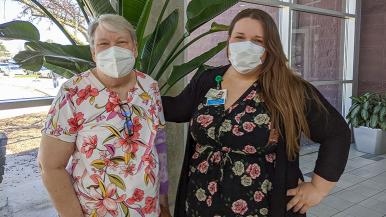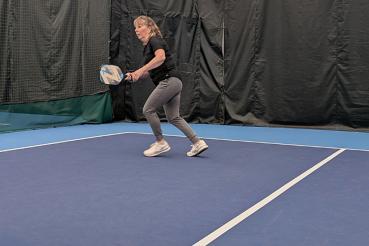After she was diagnosed with lymphedema, Barbara Schumacher learned a whole new vocabulary to describe pain.
The retiree experiences different kinds and levels of pain, so Schumacher's doctor prescribed occupational therapy to decrease her discomfort and swelling and improve her range of motion. The treatment did that — and more.
Joan Boska, an occupational therapist with Rush Copley's Outpatient Rehabilitation Therapy Center, helped Barb manage her symptoms — and gave her hope.
Barb developed moderate lymphedema in her arm and chest after surgery for breast cancer, which included removal of 20 lymph nodes. She also has mantle cell lymphoma, a form of cancer that affects the lymphatic system. Lymphedema is a buildup of fluid in soft body tissues, which caused swelling in her arm.
“It’s very painful,” Barb says, “and it never goes away. We try to control it.”
Measurable improvement
To keep her discomfort to a minimum, Barb went for occupational therapy at the Outpatient Rehabilitation Therapy Center. She saw Boska twice a week and says the sessions really helped. She saw measurable improvement.
“Joan has helped me so much,” Barb says. “There are no words to describe how wonderful she is.”
When Barb started therapy, her left arm measured 26% larger than her right arm, because of the swelling. Through treatment, that number decreased to less than 10%.
Barb’s treatment was complicated by a previously broken shoulder. In addition to lymphedema, she has scar tissue from that injury, but Boska was able to deal with both.
“Joan is very skilled in her craft,” Barb notes. “She knows what she’s doing. She was always respectful of my pain tolerance, and she always treated me with the utmost respect. She varied the sessions to give me the best outcome possible.”
The therapy sessions included exercise, massage and wrapping her arm.
Managing symptoms at home
Boska’s goals for Barb were to improve her range of motion, decrease her pain, improve the swelling in her arm and educate her on lymphedema disease self-management. Barb’s insurance covers 15 treatments a year, and Barb quickly used that up, so she needed to be able to manage her symptoms on her own.
Boska arranged for Barb to get a pneumatic sleeve and pump for use at home. She uses it once a day for an hour. It provides incremental compression and acts as a mechanical massage.
In addition, Barb bought exercise equipment, including over-the-door pulleys and rubber bands so she could continue exercising at home.
But Barb says the best thing Boska did for her was give her hope.
“For me, Joan’s greatest asset is that she gave me true hope,” Barb says. “On many occasions, I would go into the session thinking that I would never get better, but Joan always gave me hope. I always left each session more hopeful than when I went in.”




